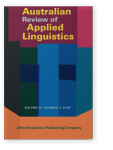Exploring the acquisition of German verb morphology by instructed learners
Research into the acquisition of L2 German word order has provided strong evidence for a sequence of incremental stages of development. Studies of the acquisition of German verb morphology so far have focused on establishing a correlation between the acquisition of word order and of verb morphology, neglecting the question how verb morphology per se is acquired. This article discusses the latter question on the basis of a qualitative analysis of longitudinal written data produced by 15 anglophone university students. It confirms some of the results of earlier studies involving tutored learners of German, such as Pienemann (1987) and Diehl et al. (2000), and provides evidence for a sequence of acquisition, as well as for a more holistic development for certain verb classes. Although most of the subjects produce perfect tense before preterite, the article suggests that teaching the preterite before the perfect tense may be feasible. It also draws attention to the importance of morphosyntactic features affecting subject-verb agreement, and calls for more research in that area.
References
Blackshire-Belay, C.
(
1991)
Language contact. Verb morphology in German of foreign workers. Tübingen: Gunter Narr.

Blackshire-Belay, C.
(
1994)
Variability in grammatical analysis: On recognizing verbal markers in foreign workers’ German. In
C. Blackshire-Belay (ed.),
Current issues in second language acquisition and development (pp. 167–185). Lanham: University Press of America.

Boss, B.
(
1996)
German grammar for beginners – the Teachability Hypothesis and its relevance to the classroom. In
C. Arbonez-Sola &
J. Rolin-Ianziti (eds),
Who’s afraid of teaching grammar? Working Papers in Language and Linguistics 1 (pp. 93–100). University of Queensland.

Boss, B.
(
2004)
Wann ich habe Freizeit, ich koche gern: Zum Erwerb der deutschen Inversion und Nebensatzwortstellung durch australische Studierende.
Deutsch als Fremdsprache, 41 (1), 28–32.

Boss, B.
(
2005)
Ist der Erwerb der deutschen Verbalflexion mit dem der Wortstellung verbunden? Beiträge der Sektion F6.
Grammatik, Erwerb & Vermittlung. XIII.IDT GRAZ. Accessed 16/02/08. Available from:
[URL].
Boss, B.; Jansen, L.M.
(
2003)
Do our students learn what we teach them? BABEL, 23 (2), 26–38.

Clahsen, H.
(
1988)
Parametrized grammatical theory and language acquisition: A study of the acquisition of verb placement and inflection by children and adults. In
S. Flynn &
W. O’Neil (Eds.),
Linguistic theory in second language acquisition (pp. 47–75). Dordrecht: Kluwer Academic Publishers.


Clahsen, H.; Meisel, J.; Pienemann, M.
(
1983)
Deutsch als Zweitsprache: der Spracherwerb ausländischer Arbeiter. Tübingen: Narr.

Diehl, E., Christen, H.; Leuenberger, S.; Pelvat, I.; Studer, T.
(
2000)
Grammatikunterricht: Alles für der Katz? Untersuchungen zum Zweitsprachenerwerb Deutsch. Tübingen: Niemeyer.

Ellis, R.
(
1989)
Are classroom and naturalistic acquisition the same? A study of the classroom acquisition of word order rules.
Studies in Second Language Acquisition, 111, 305–328.


Jordens, P.
(
1988)
The acquisition of word order in L2 Dutch and German. In
P. Jordens &
J. Lalleman (eds),
Language development (pp. 149–180). Berlin and New York: Walter de Gruyter.


Köpcke, K.-M.
(
1987)
Der Erwerb morphologischer Ausdrucksmittel durch L2-Lerner am Beispiel der Personalflexion.
Zeitschrift für Sprachwissenschaft, 6 (2),186–205.


Parodi, T.
(
1998)
Der Erwerb funktionaler Kategorien im Deutschen. Eine Untersuchung zum biligualen Erstspracherwerb und zum Zweitspracherwerb. Tübingen: Gunter Narr.

Parodi T.
(
2000)
Finiteness and verb placement in second language acquisition.
Second Language Research, 16 (4), 355–381.


Pienemann, M.
(
1989)
Is language teachable? Psycholinguistic experiments and hypotheses.
Applied Linguistics, 10 (1), 52–79.


Tschirner, E.
(
1999)
Lernergrammatiken und Grammatikprogression. In
Skibitzki, B;
Wotjak, B. (Eds.),
Linguistik und Deutsch als Fremdsprache. Festschrift für Gerhard Helbig (pp. 227–240). Tübingen: Niemeyer.

Cited by
Cited by 3 other publications
Oliver, Rhonda, Honglin Chen & Stephen Moore
2016.
Review of selected research in applied linguistics published in Australia (2008–2014).
Language Teaching 49:4
► pp. 513 ff.

Schenck, Andrew D. & Wonkyung Choi
2012.
Taking the Guesswork Out of Curriculum Design: Learning to Engineer Explicit Grammar Curricula through the Analysis of Multiple Influences on the Acquisition Process.
Open Journal of Modern Linguistics 02:03
► pp. 114 ff.

Son, Myeongeun
2024.
L2 Language Development in Oral and Written Modalities.
Studies in Second Language Acquisition ► pp. 1 ff.

This list is based on CrossRef data as of 5 july 2024. Please note that it may not be complete. Sources presented here have been supplied by the respective publishers.
Any errors therein should be reported to them.
